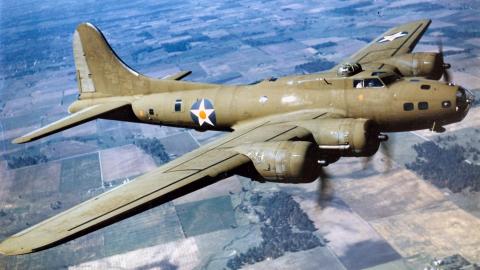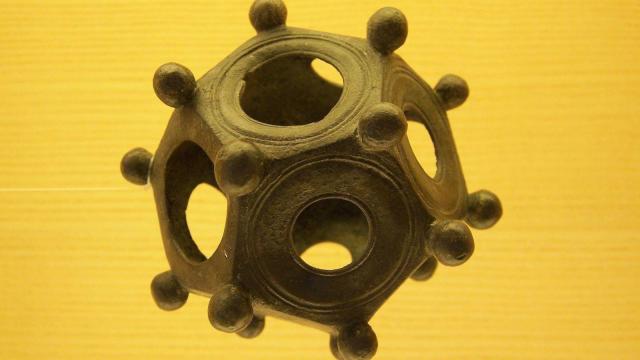How the “Bomber Mafia” planned to win World War II with just a few dozen bombs

Public Domain
- Malcolm Gladwell’s new book The Bomber Mafia traces the stories of major personalities during WWII as bombing tactics developed.
- Of particular interest to him were the men who dreamed of precision bombing as a way to make war quick, efficient, and far less deadly.
- He concludes that the Bomber Mafia was ahead of its time.
Humanity has always had the odd idea that one tactical change or new technology is going to make war painless. Nowhere is this dream presented as a greater drama than in the story of the Bomber Mafia, a group of young American Army Air Force officers who hoped to use technology developed by a grouchy Dutch genius to reduce war to a question of hitting the right targets.
Their attempt, their failure, and the triumph of their ideology is the subject of a new book, The Bomber Mafia, by author and frequent Big Think contributorMalcolm Gladwell.
The Bomber Mafia
The Bomber Mafia was a group of young Air Force pilots and officers in the 1920s and 30s. Stationed together in Alabama, they collectively dreamed up a new idea of warfare based around air power. They were led by a young romantic officer named Haywood Hansell. Their ideas were radical and, at the time, the stuff of science fiction.
They argued that a sufficiently large, well armed, high flying, and long ranged bomber fleet would always get through to target destinations, even in the face of enemy resistance. This invulnerability meant that daylight attacks — previously thought to be too dangerous to attempt — were feasible, which increased the possible accuracy of bombing runs. The invention of vastly improved precision bombsights, tools used to determine where a bomb would land after being dropped from a plane several miles up, by Dutch inventorCarl Norden provided the hardware needed to make it all work.
Taken together, the pilots believed that the precision bombing of any target, no matter how well defended, was possible.
In a presentation, these visionaries suggested that New York City could be brought to capitulation with seventeen well placed bombs. Their idea was that by focusing on targets like the electric grid, bridges, water supply, and other vital infrastructure, the ability of the city to function could be destroyed with a minimal cost to human life.
They proposed that entire wars could be won this way. Simple, effective, rapid bombing campaigns would end war quickly. There would be no more battles where tens of thousands of young men die. And unlike other theorists of the day, they thought it could be done without directly targeting civilians.
Bombing theory meets reality
The Bomber Mafia drew up the original plans for the use of American air power in Europe in line with their theories of precision bombing. It was decided that the cornerstone of the Nazi war machine was the simple ball bearing. Despite their small size, they are needed in a huge number of mechanical parts that rotate, including airplane engines. If the production of the five main ball bearing factories, all conveniently located in Schweinfurt, Bavaria, could be stopped, perhaps the war would soon follow.
A large fleet of B-17 bombers set out on a diversionary run, but the main attack force was delayed by weather for several hours. By then, the Germans were fully prepared for them when they arrived, and dozens of bombers were shot down.
Of the roughly 2000 bombs the main attack force dropped, only 80 managed to hit the factories. While ball bearing production dropped for a while, the damaged factories were soon back to full production. A follow-up attack produced similar results. While Hansell thought the attacks were successes and learning opportunities, his men started calling his bomb wing the “clay pigeons” after the targets sport shooters aim at.
While some of the failures against the target were attributable to the delayed takeoff, a large factor was the failure of the bombsight to work in non-ideal conditions. The lack of long range fighter escorts was also a majorissue.
While Nazi Armaments Minister Albert Speer would later suggest that destroying ball bearing factories could have seriously hindered German industry if further attacks were carried out, they never were. The losses were too high and the returns far too low. Over time, the American strategy in Europe slowly evolved to one more akin to simple widespread strategicbombing.
In Japan, things got even messier.
Hansell tried to use similar tactics and got similar results. It was decided that aircraft factories were the economic target this time, and he tried to hit them in the same manner as the ball bearing factories. Again, bad weather delayed attack runs and spoiled those that were carried out — after all, you cannot hit a target obscured by clouds with any kind of precision no matter how effective the bombsight is.
Making things worse, the jet stream, a then poorly understood weather phenomenon with what seemed to be impossibly high wind speeds, made serious attempts at precision bombing impossible. Even if the pilots could keep the plane steady, the bomb would be blown off course every time. Higher ups began to demand that tests of tactics that Hansell protested as counterproductive area bombardment be carried out as their faith in precision bombing as a central tool faded.
While Hansell’s last raid was effective in damaging the Japanese aircraftindustry, the lag in knowledge of the efficacy of the bombing combined with his refusal to consider new tactics led to his sacking. He was replaced by Curtis LeMay, the commander of the diversionary attack at Schweinfurt.
Bombing: the old strategy becomes the new strategy
While LeMay agreed with Hansell on the ability of bombers to win a war, he disagreed on how to implement them. Rather than bombing a narrow range of targets to bring down an economy, LeMay favored as extensive and brutal of a campaign as was required to end the war quickly — including much larger direct attacks on civilians and factory workers.
His first big idea upon replacing Hansell was to use a new incendiary weapon, napalm, against the largely wooden Japanese cities in a firebombing campaign. This campaign, based on ideas that had been discussed for years and even proposed by other members of the Bomber Mafia, was much more aggressive in its targeting of Japanese civilians than what Hansell had commanded.
The firebombing was conducted at night by low flying bombers stripped of defensive weaponry so that they could carry more bombs. There was little effort to target anything other than the vast collections of wood and paper homes of the Japanese people.
The U.S. Army Airforce dropped ton upon ton of the jellied gasoline bombs on Tokyo on March 10th, 1945. Anyone who failed to flee their homes was incinerated. Some people dove into canals for safety only to asphyxiate when the firestorm consumed the oxygen in the air. Many were trampled by others trying to escape. Others fled to parks designed to serve as refuge points in the event of earthquakes and ensuring fires. These proved no match for napalm. The majority of the casualties were women, children, and the elderly.
The stench of burning flesh reached the planes a mile above the city. Many of the late arriving bomber crews had to use oxygen masks to endure their mission. Some of the planes had to be fumigated upon landing to remove the odor.
The raid on Tokyo likely holds the record for the most people killed within a six hour period. Estimates of the death toll go as high as 100,000. The physical damage was immense. Sixteen square miles of buildings were burned, about 7 percent of the city, and a million people were left homeless. Upon reviewing pictures of the destruction they had wrought, one commander looked at the devastation and remarked, “It’s all ashes.”
This was merely the first such raid. Tokyo was hit again, and the remaining firebombing campaigns targeted all the major Japanese cities and several minor ones — except for Hiroshima and Nagasaki. Precision bombing was relegated to a situational tool as weather allowed.
Could precision bombing have worked?
In his book, Gladwell concludes that if it hadn’t been for the switch to LeMay’s tactics, the war with Japan would have dragged on for much longer. He accuses Hansell of having a case of “true believer syndrome” and failing to recognize when his tactics ceased to work.
For his part, General Hansell maintained later in life that Japan would have surrendered without the need for the atomic bombs, invasion, or Soviet intervention by no later than November 1945. In his memoir, he cites statements by several Japanese government officials who spoke on the subject of how long they thought the nation would have held out before capitulating.
Exactly how clean these tactics would have been is also another question. Recall that the plan to defeat New York City involved leaving the population without water, power, or transportation until they gave up. How that would have translated into attacks on Japan is up for debate, but it certainly would not have been pleasant. Instead of burning to death, perhaps people would have starved to death.
Even if the idea of victory through precision bombing was impossible in the 1940s, Gladwell suggests that everything the Bomber Mafia ever wanted is now possible and an established part of American military doctrines. As Gladwell says at the end of his book:
“There is a set of moral problems that can be resolved only with the application of conscience and will. Those problems are the hardest kinds of problems. But there are other problems that can be resolved with the application of human ingenuity. The genius of the Bomber Mafia was to understand that distinction — and to say We don’t have to slaughter the innocent, burn them beyond recognition, in pursuit of our military goals. We can do better. And they were right.”
Today, the U.S. Air Force has the ability to hit particular wings of designated buildings if required. Bombers aren’t even entirely necessary; drones can do it in a pinch. Technology has advanced to the point that precision wars are possible, though this ability came several decades too late for the Bomber Mafia.
In the end, Gladwell muses that although LeMay’s tactics won World War II and were used for decades afterward, Haywood Hansell eventually won the war of ideas. And the world is better for it.





